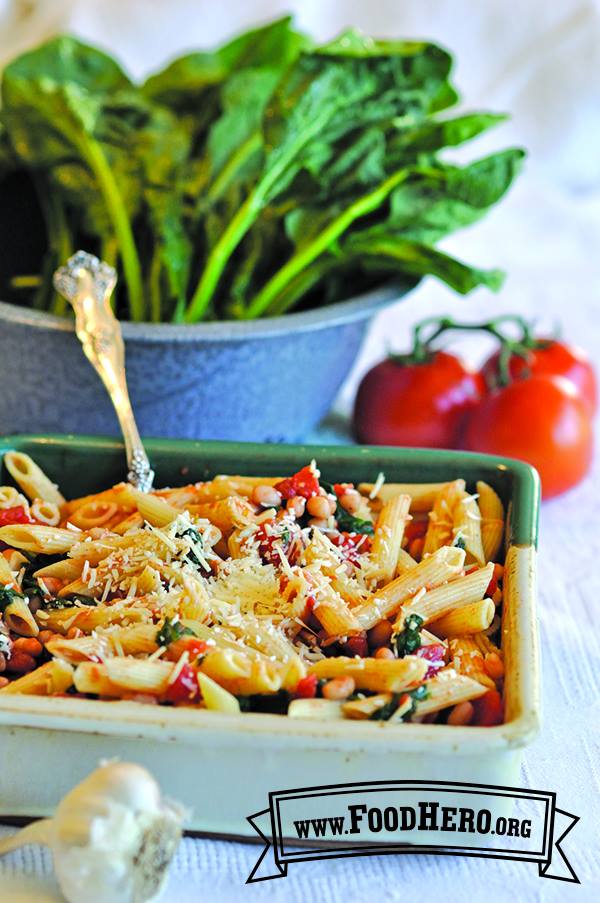We’ve all heard that we should be eating fresh fruits and vegetables as key portions of our daily meals – but at what cost? With food prices on the rise, preparing nutritious, well-rounded meals can seem like an extra strain not only on our available time but also on our wallets. Luckily, there are some strategies (and local resources!) that can help in getting the biggest bang for your buck in the grocery aisles.
- Plan ahead: Start simple by taking a look in your pantry and fridge to see what you might already have hiding in the back of a cupboard. Then try to plan a couple meals that you’ll be shopping for – a great resource for tasty, healthy, and budget-friendly recipes is the OSU Extension Food Hero website. They focus on sharing recipes that use easy-to-find ingredients and easy-to-follow directions to make healthy meals a little more stress-free.
- Consider meatless meals: Plant-based proteins like legumes, beans, lentils, or tofu are highly nutritious and often cheaper than meat at the grocery store. You might find that switching a meal or two each week to a plant-based protein like dried beans or legumes can help stretch your food dollars and still be tasty and satisfying. For preparation and cooking tips, Food Hero is a great resource, or a quick Google search will get you started.
- Shop smart: Try to stick to the list you created – you might find that eating a snack before shopping will help reduce any hunger-induced impulse buying! Look for any generic or store brand items that may be cheaper and utilize available coupons or sign up for rewards programs at your local grocery store. When debating between two of the same items that are different sizes, consider how much of the item you need or will use. Buying the larger item (or “buying in bulk”) can be a better deal for the amount you receive, but only if it’s an item that you’ll be able to use completely before it expires.
- Buy canned or frozen fruits & veggies: Fresh produce can make up a large part of a grocery bill, but canned or frozen fruits and vegetables can still provide plenty of nutrients for a better price. Just keep an eye out to avoid canned items stored in syrup or with added sugar or salt. For frozen items, look for those either stored without a sauce or labeled as “lightly sauced” to avoid extra sugar or salt.
- Utilize local resources: Food Roots is a non-profit that provides local fresh fruits and veggies, dairy and meat products here in Tillamook County. They are part of the Double Up Food Bucks program so if you spend $10 in SNAP/EBT, then they will provide another $10 of goods at no extra cost. And as an added bonus, SNAP shoppers can receive free delivery of Food Roots items, check out their website to learn more: https://www.foodrootsnw.org/
- Give yourself grace: There will always be weeks where things don’t work out quite as you hoped, and that’s okay! Remember to be kind and patient with yourself as you try out new things, and don’t feel like you need to change an entire lifestyle overnight – small steps can still have a big impact.
For inspiration, check out this quick weeknight dinner recipe from Food Hero:
Pasta with Greens and Beans
Prep Time: 10 minutes
Cook Time: 30 minutes
Ingredients
- 8 ounces pasta (try penne)
- 1 Tablespoon vegetable oil
- 3 cloves garlic, minced or 3/4 teaspoon garlic powder
- 10 ounces frozen spinach
- 1 can (15 ounces) diced tomatoes with juice
- 1 can (15 ounces) white beans, drained and rinsed
- ½ teaspoon salt
- ½ teaspoon pepper
- ½ cup grated parmesan cheese

Directions
- Wash hands with soap and water.
- Cook pasta according to package directions. Set aside.
- Meanwhile, heat oil in large skillet. Add garlic and cook on low (250 degrees F in an electric skillet) until soft.
- Add spinach, tomatoes with juice, beans, salt and pepper. Once the mixture bubbles, cook uncovered on low heat for 5 minutes.
- Add drained pasta and parmesan cheese to spinach mixture. Toss well and serve.
- Refrigerate leftovers within 2 hours.
Recipe Notes
- Substitute cleaned and chopped fresh spinach (about 6 cups).
- Try other greens, such as Swiss chard or kale instead of spinach. Be sure to clean greens well and cook them until soft.
- Cook your own dry beans. One can (15 ounces) is about 1 1/2 to 1 3/4 cups drained beans.
Article Sources:
- Strategies for Eating Well on a Budget from the Harvard School of Public Health
- Shop Smart: Tips for Every Aisle from USDA My Plate
- Eat Healthy on a Budget by Planning Ahead from the American Heart Association
AUTHOR: Tillamook County Wellness
Other wellness questions? Email us at info@tillamookcountywellness.org. For more local health and wellness information, visit www.tillamookcountywellness.org or follow Tillamook County Wellness on Facebook and Instagram.

